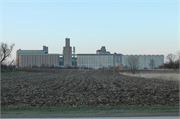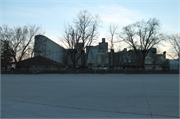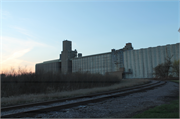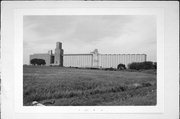Property Record
N5355 JUNCTION RD
Architecture and History Inventory
| Historic Name: | LADISH STOPPENBACH CO MALT SILOS |
|---|---|
| Other Name: | LADISH MALT CO |
| Contributing: | |
| Reference Number: | 6636 |
| Location (Address): | N5355 JUNCTION RD |
|---|---|
| County: | Jefferson |
| City: | |
| Township/Village: | Aztalan |
| Unincorporated Community: | |
| Town: | 7 |
| Range: | 14 |
| Direction: | E |
| Section: | 25 |
| Quarter Section: | SW |
| Quarter/Quarter Section: |
| Year Built: | 1898 |
|---|---|
| Additions: | |
| Survey Date: | 19742012 |
| Historic Use: | silo |
| Architectural Style: | Astylistic Utilitarian Building |
| Structural System: | |
| Wall Material: | Concrete |
| Architect: | |
| Other Buildings On Site: | |
| Demolished?: | No |
| Demolished Date: |
| National/State Register Listing Name: | Not listed |
|---|---|
| National Register Listing Date: | |
| State Register Listing Date: |
| Additional Information: | A 'site file' exists for this property. It contains additional information such as correspondence, newspaper clippings, or historical information. It is a public record and may be viewed in person at the Wisconsin Historical Society, Division of Historic Preservation. James Lytle and Joseph Stoppenbach founded the Lytle Stoppenbach Malting Company around the turn of the twentieth century. After several years’ involvement in the company, Herman W. Ladish purchased controlling interest and renamed the company the Ladish Stoppenbach Malt Company. The company’s facilities south of Johnson Creek in the Town of Aztalan grew to be considered the world’s largest malting facility. After Herman’s retirement, the company was operated by his son until its closing. The Ladish Stoppenbach Malt Co. Silos are located at N5355 Junction Road in the Town of Aztalan. Eventually, the former Ladish Stoppenbach facilities were utilized by the Cargill Company. After years of non-use, the large facility was purchased by Renew Energy to utilize as an ethanol factory in 2006. Renew Energy was the recipient of a $1.5 million Freight Rail Infrastructure Improvement Loan which helped finance the facility’s renovation. It became the largest ethanol plant in the state. However, the Renew Energy plant was financially unsuccessful and soon closed. In 2010, the 344-acre property was purchased for $72 million by Valero Renewable Fuels, LLC to continue the production of ethanol. Grain elevators like these exerted a formative influence on one of the twentieth century’s most important architectural styles. In these elevators, European modernists such as Le Corbusier and Walter Gropius found partial inspiration for the spare International Style. The sinuous lines and smooth concrete walls of the massive cylindrical elevators, silhouetted against the flat prairie landscape, matched form to function, and they also embodied the mathematical calculations of the engineer, hero of the industrial age. Grain elevators, among other modern industrial forms, inspired the International Style’s smooth curtain walls untainted by applied ornament, its rhythmic contours without axial symmetry, and its emphasis on what Le Corbusier called “the magnificent play of volumes brought together in light.” When grain merchants James Lytle and Joseph and Charles Stoppenbach formed the Lytle-Stoppenbach Company (predecessor to the Ladish Malt Company) in 1898, they simply built functional structures for malting barley, the crucial first step in brewing beer. Maltsters steep barley in vats of hot water, allow it to germinate, kiln-dry the resulting malt, then ship it to the brewer, who cooks the malt in water to make wort, the liquid beginnings of fermented beer. Although brewers did their own malting in the early years of Wisconsin’s brewing industry, a brewing boom in the 1860s and 1870s fostered a separate malting industry. Most of the surviving structures in this massive complex took shape in the years after 1936. Development, however, began in 1898; the first grain elevators stood next to the Chicago and North Western Railway tracks. Within fifteen years, the company produced one million bushels of malt per year. Most of the complex had been constructed of fireproof materials after 1904, but in 1936, an electrical fire destroyed one of the original structures. The company plowed the insurance money into a major expansion, adding steeping and germinating rooms, malt kilns, and concrete barley tanks, many 120 feet tall, linked by a continuous concrete skin and even taller elevators. These barley tanks dominate the local landscape as four enormous, flat-roofed oblongs with rounded corners, their fluted walls punctuated by stepped, skyscraper-like elevators at irregular intervals. The repetitive, undulating curves in the wall, reflecting the individual silos, give the complex the sort of visually striking character that inspired European modernists. |
|---|---|
| Bibliographic References: | Currey, Josiah Seymour. History of Milwaukee, City and County Volume 3. Chicago: The S. J. Clarke Publishing Company 1922. Sharp, Steve. “New ethanol producer settles in at Ladish site.” Daily Times, September 10, 2010. Sharp, Steve. “Work begins on largest ethanol plant in Wisconsin.” Daily Times, October 4, 2006. Buildings of Wisconsin manuscript. |
| Wisconsin Architecture and History Inventory, State Historic Preservation Office, Wisconsin Historical Society, Madison, Wisconsin |




